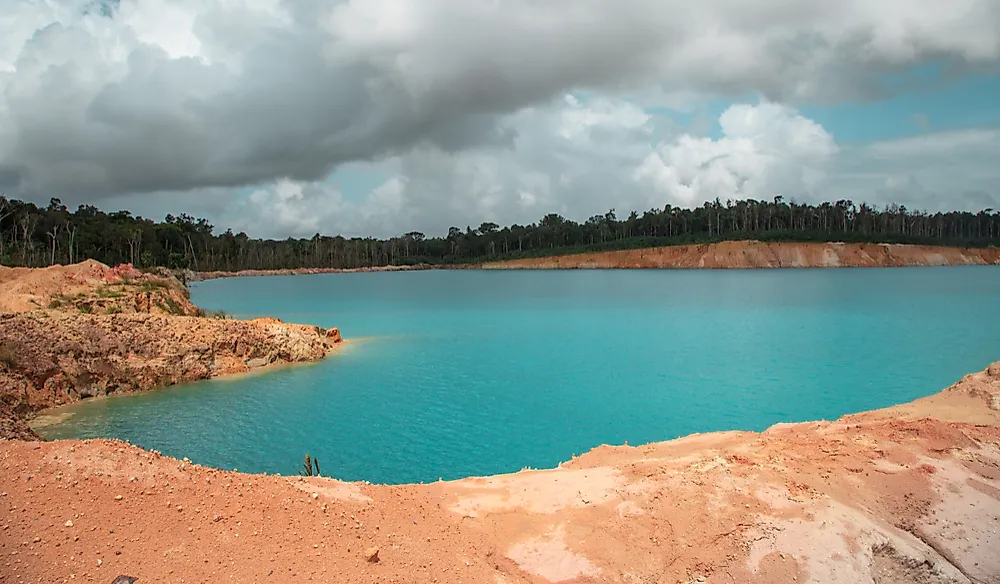What Are The Biggest Industries In Guyana?

Guyana is a South American nation. The country shares a border with Venezuela, Brazil, and Suriname as well as a maritime border with Trinidad and Tobago. Guyana is the 130th largest export economy in the world. The nation exported goods worth an estimated $2.05 billion and imported goods worth $1.88 billion resulting in a $173 million positive trade balance. The nation had a GDP of $3.62 billion in 2017. Some of the top export items in the same year were railway cargo containers which were valued at $ 239 million, gold ($848 million), raw sugar ($91.6 million), aluminum ore ($155 million), and rice ($239 million). The nation’s top imports include refined petroleum, large construction vehicles, excavation machinery, packaged medicaments, and cars. The top export destinations are Canada, the United States, Trinidad and Tobago, Panama, and Belgium-Luxembourg while imports are mainly sourced from the United States, Trinidad and Tobago, China, Suriname, and Japan.
Manufacturing
The nation’s industry and manufacturing sector contributed an estimated 10% to the GDP in 2010. The sector also employed about 12% of the population in the same year. Guyana is ranked 115th out of 180 countries in terms of ease of doing business. The ranking evaluates the conduciveness of the regulatory environment in the opening and during the operation of local firms. The sector is traditionally based on the processing of forest products, agricultural products, food, beverages, minerals pharmaceuticals, and basic consumer items for domestic consumption. However, over the years the country has begun to invest more in value-added, export-oriented industries such as the manufacture of agro-industry products, apparel, garments, construction materials, and ceramics. The processing of agricultural products such as rice, sugar, and timber are the most dominant sub-sector in manufacturing. Other significant sub-sectors include the processing of minerals such as bauxite and gold.
Mining
Guyana is among the world's largest bauxite producers. The sector accounted for about 10% of the nations GDP in 2014. The sector contributed 40% of the nation's exports in the same year. Other major mineral resources in the country include diamonds, gold, uranium, and alumina. In 2005, the nation produced 356,950 carats of diamonds, 262,528 ounces of gold, and 1.76 million tons of bauxite. Some mining corporations operate in the nation including RUSAL and BHP Billiton which are large international mining firms. The sector is governed by the Guyana Geology and Mines Commission.
Agriculture Industry
The agricultural sector coupled with fisheries and forestry accounted for 17% of the nations GDP in 2010. The sector also employs about 15% of the nation's population. Agriculture is practiced on 8.5% on the country’s territory. The rice and sugar industries are the largest in the sector. Other agricultural products produced by the nation include poultry, beef, pork, and edible oils. Sugar production has been the nation's traditional source of foreign exchange while rice has been the nation’s main staple food. However, production has been on the decline since 1980 due to high production cost that affects the sugar's competitiveness on the global stage. Rice production has also been on the decline due to the reduction of guaranteed prices of the commodity among other challenges in the global trading environment. Despite the challenges, rice and sugar remain the most profitable crops in the nation. Exports of the rice generated $173 million in 2010 while exports of sugar in the same year generated $116.5 million. In remote areas such as Rupununi, peanut production is the most dominant source of income for farmers. Agriculture in the nation is limited by the landscape. Large plains exist below sea level meaning that large dikes have to be constructed for protection thereby raising the cost of agricultural production. The savannah in the nation's interior is best suited for ranching. High transportation costs incurred due to the remoteness of some regions is also a significant challenge to the sector's growth. The government has increased emphasis on the sector to boost production and profitability.
Construction and Engineering Industry
The construction industry accounted for 7% of the nations GDP in 2008. Government and privately funded projects are the primary drivers of the sector. The main projects undertaken include construction of bridges, hospitals, and roads to support the nations much larger mining and agricultural sectors. The nation’s development strategy is anchored in the industry through the construction of critical infrastructure.
Tourism Industry
The tourism industry in the nation employed an estimated 25,500 people representing 8% of the nation's employment in 2011. The sector accounted for 9.2% of the nations GDP in the same year, which put it at position 86 out of 181 countries in terms of the tourism sector’s contribution to the economy (the world average is 14%). The nation welcomed 150,000 visitors in 2010.
Future Prospects
The government of Guyana has been keen on ensuring the growth of the economy and fostering conditions that create opportunities for expansion and renewal in the economy. The nation experienced economic growth averaging 3% between 2015 and 2017 while its neighbors experienced low and negative growth rates. The economic growth projections for 2018 and 2019 were put at 1.9% and 2.6% respectively. The nation is also expected to witness a 10% increase in exports in the coming years. The nation continues to concentrate on various approaches to economic growth including improving national planning, enabling diversification in the economy, building a robust oil industry, and strengthening the private sector.











